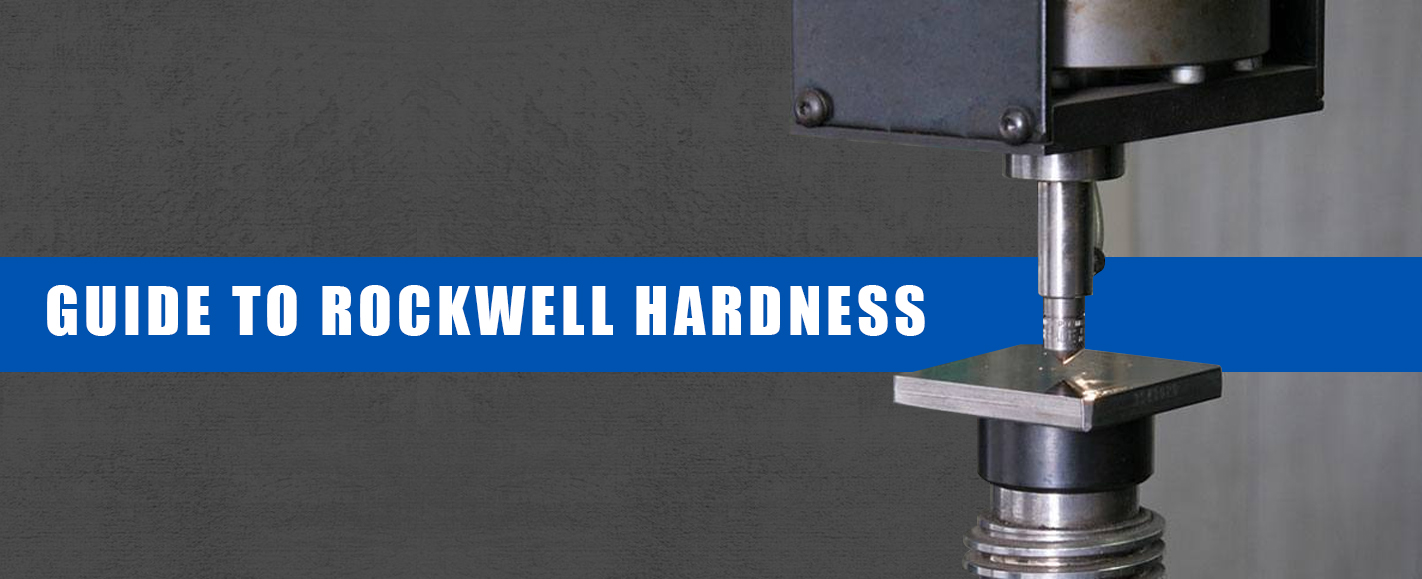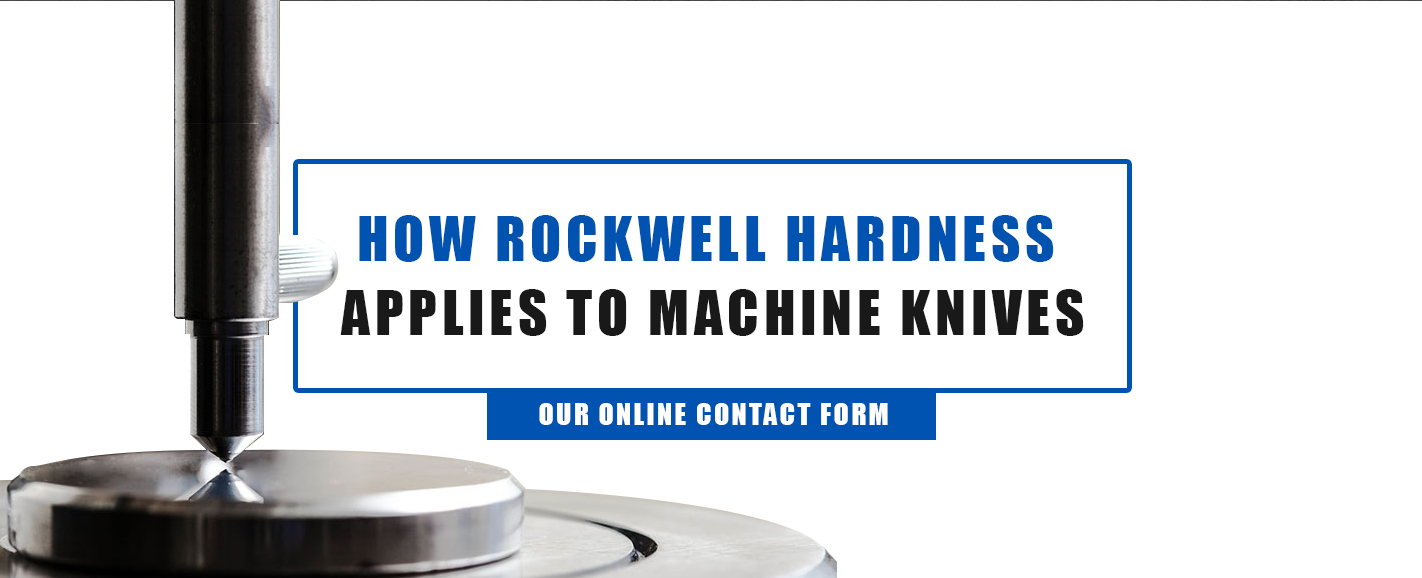
If you’re in a business that uses any cutting tool, you’ll likely be familiar with the term “Rockwell hardness.” However, you might not know precisely what Rockwell hardness is. You’ll see a value attached to your cutting knives expressed as “Rockwell C” with a number attached, such as “RC45” or “RC60.” But what is the RC scale?

What Is Rockwell Hardness?
The most straightforward answer is that Rockwell hardness refers to how resistant a metal object such as a knife blade is to penetration and permanent deformation from another material. It’s a measuring system of non-destructive metallurgical testing that determines how hard and strong steel such as that used in knife-making truly is. To accurately express metal hardness, engineers use a standard process called Rockwell testing.
In the knife blade manufacturing business, hardness ratings follow a predetermined chart which is commonly called the Rockwell C scale. The higher the number on the RC scale, the harder the steel is. Conversely, the lower the RC scale number is, the softer the steel. Most alloys in knife blades range from soft steels in the RC45 range to hard metals rated in the RC60 category.
It’s a misconception to think high RC ratings mean better-quality knives. It depends entirely on a blade’s intended use as to what hardness knife makers specify for their steel. As a rule of thumb, softer steels such as those rated at RC45 are more durable and withstand impact better than hard steel rated at RC60. Hard steel blades hold their edge longer than soft material. However, they can be brittle and tend to chip or even shatter under impact.
Experienced knife blade manufacturers design their products to match their purpose. They strive for a balance between soft RC-scale steel that remains durable and a hard RC-scale material that keeps a sharp edge for a long time. To get the right steel for the intended application, quality knife manufacturers prescribe a specific steel strength. Then they test it to ensure the blade meets an exact number on the Rockwell hardness scale.
Who Uses the Rockwell Hardness Scale and Why
Every American steel product manufacturer uses the Rockwell hardness scale. The RC scale is the industry standard, regardless of whether products are ball bearings or knife blades. Two industry authorities prescribe Rockwell tests and how to conduct them. All steel product manufacturers refer to:
- American Standard Test Method for Rockwell Hardness and Rockwell Superficial Hardness of Metallic Materials (ASTM E 18 Metals)
- International Standards Organization – Rockwell Hardness Test Part 1 – Test Method (ISO 6508-1 Metallic Materials)
The reason all steel product manufacturers use the Rockwell hardness scale is that it allows uniformity in reporting test results. Everyone in the steel industry recognizes the Rockwell hardness scale. They quickly know steel strength from a glance at its Rockwell rating. The Rockwell system is universally accepted as a hardness baseline. That’s particularly so in knife blade manufacturing.
When ordering or selecting industrial machine knives, it’s vital to understand the Rockwell rating system. Knowing what Rockwell scale strength you require ensures you’re getting exactly what blade hardness you need. It’s also important to remember that industrial knife blade makers will temper your blades to a specific Rockwell number. Then, they test your knives and make sure they conform to the prescribed Rockwell hardness scale number.
Another reason why knife makers and other steel product manufacturers refer to the Rockwell hardness scale is that it’s simple to use and self-contained. Rockwell testing is fast and exceptionally reliable. There is no need for secondary microscopic examination, as Rockwell tests are external force applications and mathematically measured.
History of the Rockwell Hardness Scale
The Rockwell hardness scale gets its name from its inventors, Hugh M. Rockwell and Stanley P. Rockwell. The Rockwell brothers were metallurgists working in a Connecticut ball bearing factory back in the early 1900s. They recognized the need for accurately and quickly testing metal strength in bearing races. They also required a clear method for reporting strength test results.
Stanley Rockwell patented the Rockwell testing method in 1914. In 1919, he amended the patent to include the Rockwell scale chart. While industrial knife steel rating usually falls in a number associated with the Rockwell C scale, there are 30 different scales on the patented Rockwell scale chart. C is the most common scale used for knife blade ratings, followed by the B scale. None of the other Rockwell scales pertain to steel used in making industrial knives.
Rockwell recognized his hardness testing method had to fall within specific parameters. His system replaced earlier metal testing systems, like the older Vickers test that was too time-consuming and the Brinell metal test that was too destructive, especially on small parts. To design an effective testing system, Stanley Rockwell took in these considerations:
- The system had to be inexpensive to acquire and maintain.
- All testing equipment must be as non-destructive as possible.
- Testing equipment needed easy implementation.
- It allowed easy training and supervision of operators.
- Testing personnel had understandable, written procedures to follow.
- Test results had valuable information users needed.
The Rockwell hardness testing method fulfilled every requirement. After 100 years, it’s still the best metal strength test method. The Rockwell C scale is also the most precise way to report metal strength used in industrial machine knives.
How Rockwell Hardness Gets Measured
Measuring Rockwell hardness requires applying specific static force to a metal surface for a definite time using precise recording measuring procedures. Rockwell testers express their results with a mathematical formula associated with a corresponding number on the standard Rockwell scale. Industrial knives will fall somewhere along the Rockwell scale’s C schedule, with a number from as low as 40 to as high as 65.
For knife making, the Rockwell procedure involves static indentation testing, which requires two different tests. The first is a small pressure application that determines metal hardness or resistance under a light, precisely controlled force. The indentation tool, or indenter as it’s called in the Rockwell testing business, makes a slight impression on the metal being tested. This depth — Value A — gets measured and recorded. It serves as a base for calculations.
The second test part involves applying a much heavier force to the same spot on the metal surface. That penetration level — Value B — also gets measured and recorded. Then, the testing technician deducts the light penetration value (A) from the deep penetration measurement (B). The numeric value of B minus A then gets transferred to the Rockwell C scale, and its corresponding value becomes the metal’s Rockwell hardness indicator.
How Technicians Perform the Rockwell Hardness Test
Rockwell hardness testing equipment is quite straightforward. It involves a mechanical operation where an indenting tool gets pressed against the metal subject surface at different rates while the indentation depth gets recorded. Testing technicians accurately control pressure application set according to what metal type they’re working with.
There are two different indentation tool designs: One is a conical device with a sharp point, while the other is ball-shaped with a round surface. Both tools are much harder than the metal they are testing. Often, indenters are a diamond composition or made of high-strength steel, which is to avoid any compression in the inverter head, so all pressure gets evenly applied to the test material.
Rockwell testing technicians use two force applications. One is the minor force, which creates the shallow, baseline indentation. The other is called the major force. It causes the deeper, secondary indentation. Performing a Rockwell test consists of these seven steps:
- Setting the test object on a flat, solid surface — it’s vital to remove any condition that allows the test material to flex or otherwise transfer application pressure.
- Applying the preliminary or minor force — this pressure is normally around 10 kg, and it creates a slight impression which is almost invisible to the eye.
- Zeroing the measuring gauge and measuring the initial indentation depth — which can be automatically done on advanced Rockwell testing equipment or manually done with a dial indicator on simple equipment.
- Applying the major or secondary force — this gradual process ranges from 60 to 150 kg, depending on the steel type. Denser steel alloys require greater pressure to create a calculable B – A value.
- Removing the secondary or major force while leaving the minor or primary force intact — this step compensates for elastic or stretching in the test metal while calculations are underway.
- Measuring the secondary indentation depth — again, this can be automatic or manual measurements depending on the test equipment complexity.
- Calculating the depth differential, or B – A value — this figure then transfers to the Rockwell C scale chart and becomes the Rockwell hardness number.
The Rockwell hardness number is not the same as the calculated depth differential measurement. Softer metals allow for deeper penetration than harder metals, so the B – A value will always be higher on soft metal test subjects than hard metals. The Rockwell hardness scale number appears inverse to the depth differential calculation. For instance, a soft Rockwell value is 45, whereas a hard value is 60.
What Does a High RC Rating Mean?
A high Rockwell C rating means the tested steel is high-strength. Any value ranging in the mid-50s and above on the Rockwell C scale is considered hard. However, a high number on the RC scale doesn’t necessarily mean it’s the best steel for a particular application. While the steel may be of excellent quality, it might underperform softer-rated steel.
Two terms accompany soft and hard Rockwell C-rated steel. Those are malleable and brittle. The harder a steel becomes, the more brittle it is. With industrial machine knives, extremely hard steel with an RC number in the 60s may be too fragile to use reliably. High-rated RC hardness steels maintain their edge well, but it’s difficult to achieve sufficient sharpness.
Highly durable steel requires sharpening stones made of ceramic or diamond. These materials are expensive and require considerable skill to work with. Once a fine edge is set on high RC-rated knives, it keeps its hone well until some other hard object contacts the blade, which could result in the blade chipping or even shattering.
High-rated steels have their place in industrial knife fabrication. However, there is a hardness point that’s unproductive. Selecting the right steel hardness for knife making can be a tough choice. It’s something that requires professional help.
What Does a Low RC Rating Mean?
Low RC ratings indicate softer steel composition. Soft steels are malleable, meaning they can bend and deflect better than hard and brittle steel. They can be advantageous for making industrial machine knives, as low RC-rated products tend to be forgiving when they accidentally come into contact with objects that are not intended to be cut.
Soft steels used in knife making rate in the 40s and low 50s on the Rockwell C scale. While softer steels might not hold a sharp edge as well as hard materials, they’re easy to sharpen. Maintaining soft steel knives requires less expensive sharpening equipment. Sharpening technique or skill is also less necessary with lower-rated Rockwell C steels.
There’s a tradeoff between using soft steel knives and those with a high RC scale rating. Hard steel will last longer than soft materials between sharpening. However, when hard steel products lose their edge or suffer damage, they’re more difficult to repair. High RC-rated steel knives can also be more expensive to replace.
Why There Are a Range of RC Numbers
Industrial knife blade manufacturers offer a range of RC numbers in their steel stock so they can provide a variety of selection options to their clients. Every business or company that uses industrial knives in their operation will have specific intentions. The key is matching the right steel hardness to the proper application.
Professional machine knife blade manufacturers know their steel inventory. They’re also capable of tempering existing steel stock to accommodate a certain RC scale hardness their clients require. Part of an industrial machine knife manufacturer’s role is listening to customers and determining the exact hardness their particular blade applications need. They know what to recommend from the wide range of RC numbers.
Practical Use of Rockwell Hardness
Every industrial machine knife blade has an existing Rockwell hardness. Leading knife blade manufacturers have the experience to recommend and match the right RC hardness for practical uses, which could be cutting anything from paper to plastics.
York Saw & Knife is one of America’s leading industrial machine knife manufacturers. At York, we work with you as a customer to identify the practical use your knives face. We then guide you through the Rockwell C hardness scale your knife blade steel requires. Here are some of the possible uses you’ll find York Saw & Knife blades applied to:
- Rotary Slitter Knives
- Paper Core Saws
- Cutoff Knives
- Straight Edge Knives
- Tray Forming & Sealing Knives
- Guillotine-Style Cutters
- Slitting Knives
How Rockwell Hardness Applies to Machine Knives
Selecting the right steel strength is vitally important for your industrial machine knives to perform properly and profitably. It’s important to know that steel strength isn’t related to quality. All York Saw & Knife blades are of the highest manufacturing quality, starting with high-grade steel. York blades are all of the same caliber, regardless whether their steel has a high, medium or low Rockwell C hardness rating.
York Saw & Knife uses Rockwell hardness testing on all our customers’ blades as part of our quality-control process. If you require a soft steel alloy in the RC 40 range, you can be sure our techs have tested it to verify that hardness rating before we ship it from the factory. Likewise, if you’ve ordered tough blades with tensile hardness in the RC 60 scale, you can rest assured we have verified those blades to meet your needs.
Rockwell testing is part of our quality commitment at York Saw & Knife. Since 1906, we’ve been manufacturing durable, accurate blades at affordable prices. Since then, our precision knife and saw blades have served thousands of American businesses to stay sharp and prosperous. For more information on Rockwell hardness testing and how you can benefit from this technology, contact York Saw & Knife today at 717-276-0338. You can also reach us through our online contact form.




